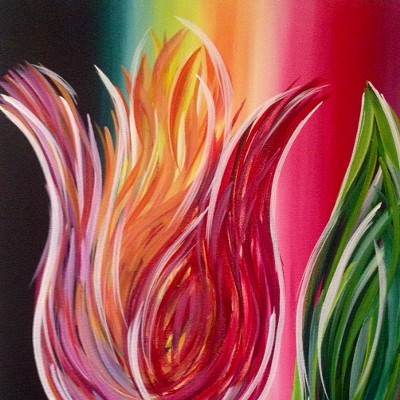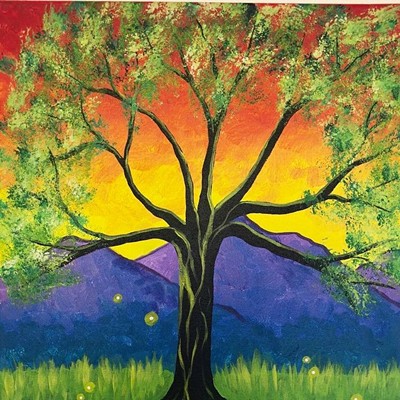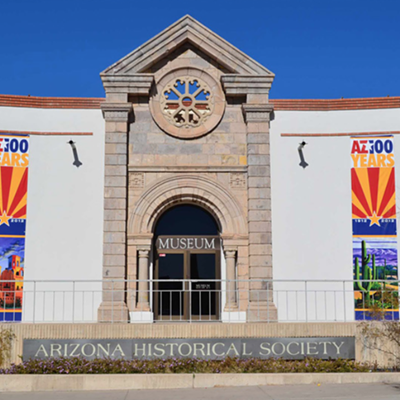Vanier Galleries
Emmi Whitehorse: Red Water and Anthony Pessler: Drawings
Vanier Galleries is one of several new galleries bringing the Scottsdale art scene down south by establishing adjunct galleries in Tucson. Vanier Galleries' immense exhibition space in Casas Adobes Plaza at Oracle and Ina roads will be showing the international, national, Arizona and Tucson artists that it represents in Scottsdale.
Although Emmi Whitehorse, a member of the Navajo Nation who lives in Santa Fe, balks at being categorized as a Native American artist, she is one of the best known contemporary Native American artists in the United States. The abstract paintings in Whitehorse's "Red Water" series translate the movement of water into color, so that in "Red Water Flows" horizontal washes of rose shift upward into darker, more saturated reds. Finally, the colors, created by layers and layers of paint, begin to lighten through rose into taupe. Spiral forms, symbolizing waves, are scattered like petroglyphs throughout the image. Even the simple icons of bird, flower and White Shell Woman from Whitehorse's earlier work have disappeared. All that remains is the quiet of water.
Anthony Pessler is the perfect example of an artist of national stature who lives just up the road. Pessler, who is an assistant professor of art at Arizona State University, represented the United States at the prestigious 2001 Venice Biennale. Many of Pessler's small graphite-on-panel drawings are dark nightscapes with a sky of clouds filled with a magical light. Yet Pessler sets these images up as something more than beautiful landscapes, as something almost religious, and in most cases he carries it off.
Emmi Whitehorse: Red Water and Anthony Pessler: Drawings continue at Vanier Galleries through March 31. For more information, call 797-4224.
Victoria Boyce Galleries
Applied Mythology
Where Vanier Galleries has established itself on Tucson's northwest side, Victoria Boyce Galleries, another Scottsdale adjunct gallery, has set up shop in the El Cortijo Art Annex up in the Foothills at Campbell Avenue and Skyline Drive. In his one-person exhibition Applied Mythology, Montana artist Stephen Schultz draws on classical mythology, Biblical history and his personal life to create narrative paintings that capture a sense of mystery about the scenes they depict. Schultz's "Expulsion" is a monumental oil-on-canvas vision of the expulsion of Adam and Eve from Eden. Schultz's dramatic light and his simplification of the narrative into a scene of Adam literally opening a curtain to the world makes an all too familiar story new.
Applied Mythology continues at Victoria Boyce Galleries through April 7. For more information, call 615-2236.
Tucson/Pima Arts Council Gallery
Ancient Skins: A Three-Person Exhibition by Michael Cajero, Catherine Nash and Robert Renfrow
Despite winning a 1993-94 National Endowment for the Arts fellowship, native Tucsonan Michael Cajero has received neither the attention nor the exhibitions that his work merits. That is clear from his installation in Ancient Skins. If people could be burned to a crisp and still continue to live, Cajero can imagine what their world would be like. Their skin and clothes flayed to black strips and their lives a desperate struggle, some men and women are screaming and fighting with sticks and stones. Despite it all, one man is playing a saxophone, and another is playing a bass. Even though Cajero's sculptures are made of papier mâché mounted on metal armatures, they almost seem to have the solidity of bronze.
For a break from Cajero's intensity, viewers can sit in Catherine Nash's installation "Within Skin: A Passage." This tent constructed of handmade Japanese paper has a floor of pine needles and the relaxing sound of running water. Robert Renfrow contributes photographs created using alternative photographic processes to comment on development and conservation in the desert.
Ancient Skins continues at the T/PAC Gallery through April 4. T/PAC is closed on weekends. For more information, call 624-0595.
Davis Dominguez Gallery
New Abstract Works
New Abstract Works, a two-person exhibition, reveals discovery for one Tucson artist and continuity for another. Five years ago, Josh Goldberg was applying white and gray acrylic and pencil on black tar paper. Goldberg's palette had lightened up since then, but his newest abstract paintings blossom in a spectrum of saturated colors. "Soft Nubbed, Dusk Fending," a long, narrow acrylic-on-paper work, reads almost like an abstract sunset on a Japanese scroll. Gold from the setting sun and burgundy from the coming nightfall hover above the bleached sea foam of the ocean. Colors substitute for words in the work of an artist who is always inspired by poetry and literature.
Tucsonan Fred Borcherdt continues his 1985 "Marker" series. Most of these works, plus his "Anchors," combine large, smooth rocks with bent and forged steel. Borcherdt has long been interested in the many reasons that people leave markers in nature, from directions to memorials. His stalwart pieces like "Desert Anchor," which features a forged-steel rod literally thrust through two oval rocks, will claim their piece of ground when they find a home.
New Abstract Works continues at Davis Dominguez Gallery through April 6. For information, call 629-9759.
Temple Gallery
Gary Benna: Romantic Reliquaries, Etc.
Through the years, Tucson ceramic artist Gary Benna has manipulated the form of the vase to make it everything but a traditional functional object. His exhibition Romantic Reliquaries, Etc. includes both his last pieces based on classical Greco-Roman vases and his newest pieces that draw on popular culture. In a great combination of old and new, "When I Saw Her Standing There" has a matte, pastel vision of Botticelli's "Birth of Venus" (the goddess standing on a clamshell in the sea) on the back of the vase. The front side of the vase is open to reveal a shiny, brightly-colored jukebox playing a 45 rpm record of The Beatles' "When I Saw Her Standing There." With only 10 pieces, Romantic Reliquaries, Etc. has some of Benna's finest.
Gary Benna: Romantic Reliquaries, Etc. continues at the Temple Gallery through April 10. The Temple Gallery is closed weekends. For more information, call 624-7370.










